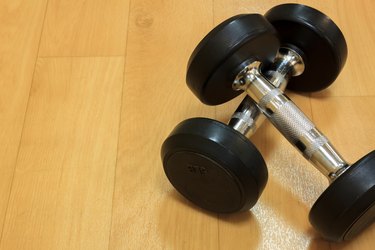
How you execute a dumbbell shrug, sometimes referred to as the shoulder shrug, determines whether you're strengthening your trapezius muscles or risking an injury. A properly performed dumbbell shrug involves holding the weights straight by your side and using your trapezius muscles to shrug your shoulders toward your ears before slowly returning to your starting position. Improper posture, excessive range of motion and overloading your dumbbell weights can leave you injured.
Back Strain
Video of the Day
Safely engaging your upper trapezius, middle trapezius and scapular muscles requires proper posture. Incorrect posture, such as slouching, offsets this alignment through your spine and neck. Hunching forces the middle of your back to assume the resistance of your weights instead of targeting your upper trapezius muscle. Over time, this can lead to the same type of strain you would experience from sitting hunched over a computer all day.
Video of the Day
Rotator Cuff Damage
Rolling your shoulders is for stretching, not weightlifting. One of the most common errors when performing dumbbell shoulder shrugs is rolling your shoulders instead of lifting them straight up and down. Your arms hang by your sides on the transverse plane, also known as the vertical plane. It becomes unsafe and ineffective because the momentum of your rolling shoulders is moving the dumbbell instead of your trapezius muscles. The result is unnecessarily straining or even tearing your rotator cuffs.
Neck Strain
Shrugging barbells without your head in the correct position can cause alignment-related injuries and neck pain. Struggling to shrug more weight than you're able increases this risk. It's impossible to fully engage your upper and middle trapezius muscles if you're tossing your head back, hanging it forward or moving it around in circles. This disrupts the alignment of your spine and forces your neck muscles instead of your upper trapezius to compensate.
Muscle Tear
Unlike push-ups or squats, which engage several major muscle groups, shrugging dumbbells focuses the majority of resistance on your upper trapezius. Overloading your dumbbell weight while performing a single vertical movement can pull or tear your trapezius muscle. Because you're only focusing on a single muscle while shrugging, overloading your dumbbells puts tremendous risk on one area. Tearing can also occur if you let your shoulders fall from the shrug instead of using your muscles to lowering them gradually . Keep your arms extended during the exercise. Performing the exercise with arms bent at the elbow could strain the forearm.